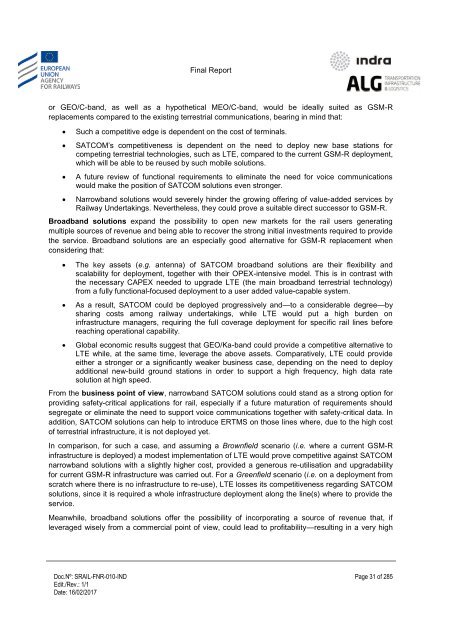Study on feasibility of SATCOM for railway communication
SRAIL-FNR-010-IND%20-%20FinalReport_v1.1_20170216
SRAIL-FNR-010-IND%20-%20FinalReport_v1.1_20170216
Create successful ePaper yourself
Turn your PDF publications into a flip-book with our unique Google optimized e-Paper software.
Final Report<br />
or GEO/C-band, as well as a hypothetical MEO/C-band, would be ideally suited as GSM-R<br />
replacements compared to the existing terrestrial communicati<strong>on</strong>s, bearing in mind that:<br />
<br />
<br />
<br />
<br />
Such a competitive edge is dependent <strong>on</strong> the cost <strong>of</strong> terminals.<br />
<strong>SATCOM</strong>‘s competitiveness is dependent <strong>on</strong> the need to deploy new base stati<strong>on</strong>s <strong>for</strong><br />
competing terrestrial technologies, such as LTE, compared to the current GSM-R deployment,<br />
which will be able to be reused by such mobile soluti<strong>on</strong>s.<br />
A future review <strong>of</strong> functi<strong>on</strong>al requirements to eliminate the need <strong>for</strong> voice communicati<strong>on</strong>s<br />
would make the positi<strong>on</strong> <strong>of</strong> <strong>SATCOM</strong> soluti<strong>on</strong>s even str<strong>on</strong>ger.<br />
Narrowband soluti<strong>on</strong>s would severely hinder the growing <strong>of</strong>fering <strong>of</strong> value-added services by<br />
Railway Undertakings. Nevertheless, they could prove a suitable direct successor to GSM-R.<br />
Broadband soluti<strong>on</strong>s expand the possibility to open new markets <strong>for</strong> the rail users generating<br />
multiple sources <strong>of</strong> revenue and being able to recover the str<strong>on</strong>g initial investments required to provide<br />
the service. Broadband soluti<strong>on</strong>s are an especially good alternative <strong>for</strong> GSM-R replacement when<br />
c<strong>on</strong>sidering that:<br />
<br />
<br />
<br />
The key assets (e.g. antenna) <strong>of</strong> <strong>SATCOM</strong> broadband soluti<strong>on</strong>s are their flexibility and<br />
scalability <strong>for</strong> deployment, together with their OPEX-intensive model. This is in c<strong>on</strong>trast with<br />
the necessary CAPEX needed to upgrade LTE (the main broadband terrestrial technology)<br />
from a fully functi<strong>on</strong>al-focused deployment to a user added value-capable system.<br />
As a result, <strong>SATCOM</strong> could be deployed progressively and—to a c<strong>on</strong>siderable degree—by<br />
sharing costs am<strong>on</strong>g <strong>railway</strong> undertakings, while LTE would put a high burden <strong>on</strong><br />
infrastructure managers, requiring the full coverage deployment <strong>for</strong> specific rail lines be<strong>for</strong>e<br />
reaching operati<strong>on</strong>al capability.<br />
Global ec<strong>on</strong>omic results suggest that GEO/Ka-band could provide a competitive alternative to<br />
LTE while, at the same time, leverage the above assets. Comparatively, LTE could provide<br />
either a str<strong>on</strong>ger or a significantly weaker business case, depending <strong>on</strong> the need to deploy<br />
additi<strong>on</strong>al new-build ground stati<strong>on</strong>s in order to support a high frequency, high data rate<br />
soluti<strong>on</strong> at high speed.<br />
From the business point <strong>of</strong> view, narrowband <strong>SATCOM</strong> soluti<strong>on</strong>s could stand as a str<strong>on</strong>g opti<strong>on</strong> <strong>for</strong><br />
providing safety-critical applicati<strong>on</strong>s <strong>for</strong> rail, especially if a future maturati<strong>on</strong> <strong>of</strong> requirements should<br />
segregate or eliminate the need to support voice communicati<strong>on</strong>s together with safety-critical data. In<br />
additi<strong>on</strong>, <strong>SATCOM</strong> soluti<strong>on</strong>s can help to introduce ERTMS <strong>on</strong> those lines where, due to the high cost<br />
<strong>of</strong> terrestrial infrastructure, it is not deployed yet.<br />
In comparis<strong>on</strong>, <strong>for</strong> such a case, and assuming a Brownfield scenario (i.e. where a current GSM-R<br />
infrastructure is deployed) a modest implementati<strong>on</strong> <strong>of</strong> LTE would prove competitive against <strong>SATCOM</strong><br />
narrowband soluti<strong>on</strong>s with a slightly higher cost, provided a generous re-utilisati<strong>on</strong> and upgradability<br />
<strong>for</strong> current GSM-R infrastructure was carried out. For a Greenfield scenario (i.e. <strong>on</strong> a deployment from<br />
scratch where there is no infrastructure to re-use), LTE losses its competitiveness regarding <strong>SATCOM</strong><br />
soluti<strong>on</strong>s, since it is required a whole infrastructure deployment al<strong>on</strong>g the line(s) where to provide the<br />
service.<br />
Meanwhile, broadband soluti<strong>on</strong>s <strong>of</strong>fer the possibility <strong>of</strong> incorporating a source <strong>of</strong> revenue that, if<br />
leveraged wisely from a commercial point <strong>of</strong> view, could lead to pr<strong>of</strong>itability—resulting in a very high<br />
Doc.Nº: SRAIL-FNR-010-IND<br />
Edit./Rev.: 1/1<br />
Date: 16/02/2017<br />
Page 31 <strong>of</strong> 285


